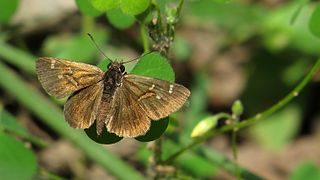
Skippers are a group of butterflies placed in the family Hesperiidae within the order Lepidoptera. They were previously placed in a separate superfamily, Hesperioidea; however, the most recent taxonomy places the family in the superfamily Papilionoidea, the butterflies. They are named for their quick, darting flight habits. Most have their antenna tips modified into narrow, hook-like projections. Moreover, skippers mostly have an absence of wing-coupling structure available in most moths. More than 3500 species of skippers are recognized, and they occur worldwide, but with the greatest diversity in the Neotropical regions of Central and South America.

Spialia galba, the Indian grizzled skipper, is a hesperiid butterfly which is found in South Asia and parts of Southeast Asia.

Orsotriaena medus is a butterfly found in south Asia, southeast Asia, and Australia. It is the only species in the genus Orsotriaena, first described by Hans Daniel Johan Wallengren in 1858.

Celaenorrhinus munda, also known as the Himalayan spotted flat, is a species of hesperiid butterfly found in South Asia.

Trapezitinae is a subfamily of the Hesperiidae ("skippers") family of butterflies. They are found only in New Guinea and Australia. The subfamily contains about 60 species in 20 genera.
Lophozancla is a monotypic moth genus of the family Erebidae. Its only species, Lophozancla prolixa, is found in Australia's Western Australia and the Northern Territory. Both the genus and the species were first described by Turner in 1932.
Parerastria is a monotypic moth genus of the family Noctuidae. Its only species, Parerastria castaneata, is found in the Australian states of Queensland and New South Wales. Both the species and the genus were first described by Warren in 1914.
Pherechoa is a monotypic moth genus of the family Erebidae. Its only species, Pherechoa crypsichlora, is known from the Australian state of Queensland. Both the genus and the species were first described by Turner in 1932.

Burca is a genus of skipper butterflies in the family Hesperiidae. The genus was erected by Ernest Layton Bell and William Phillips Comstock in 1948.
Diaeus is a genus of skipper butterflies in the family Hesperiidae. The genus was erected by Frederick DuCane Godman and Osbert Salvin in 1895.

Hesperilla is a genus of skipper butterflies in the family Hesperiidae, found throughout most of Australia.

Quedara is a genus of grass skipper butterflies in the family Hesperiidae. The genus was erected by Charles Swinhoe in 1919.

Toxidia is a genus of butterflies in the subfamily Trapezitinae of family Hesperiidae. The contained species are found in the Australasian realm.

Hesperilla idothea, commonly known as the flame sedge-skipper, is a species of butterfly in the family Hesperiidae. It is found in the Australian states of New South Wales, Queensland, South Australia and Victoria.










